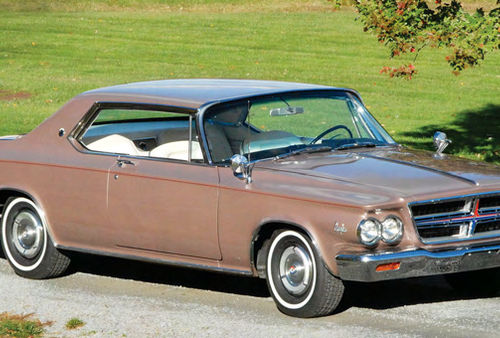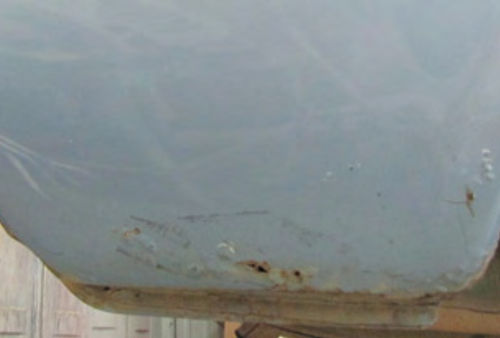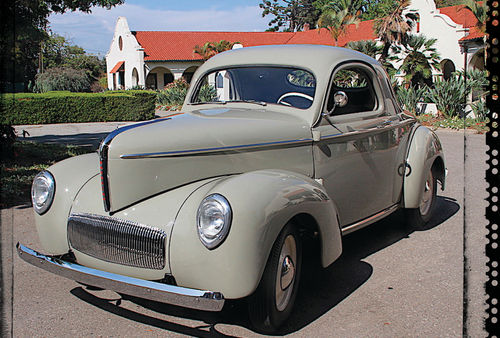1960's Ford Starliners
The 1961 Fords marked a return to a style Ford called “the classic look? In a way the classic look was an admission of a mistake—that mistake being the 1960 model. The full-sized ’60 Fords were a departure from the styling that was distinctively Ford. It was a familiar look that the public had come to expect from the conservative company. Some would say the 1960 models were so radically different most people did not realize they were Ford products.
Ford sales reached 1,439,370 cars in 1960. That was slightly less than the 1,450,953 built in 1959. At first glance that doesn’t sound so bad. But upon closer inspection, the 1960 figure includes 435,676 compact Falcons, a car that didn’t exist one year earlier. It does not take a rocket scientist to determine the full-sized ’60 Fords were a disaster for the company.

The 1961 models were styled to resemble the popular 195759 models with conservative fins and large round taillights. Perhaps as a reaction to quell some discontent, The Ford Dealer Magazine dated September/October 1960 described the new look: “In a year when heavy emphasis is being placed on the loyalty of Ford owners—when every effort is being expended to build friends for Ford— the Classic Look, so well accepted in the past, has been restored to the 1961 Ford. It’s literally custom built to win friends and keep them.” The new styling—traditional though it was—did little to reverse the downward sales spiral. Production of the big Fords in 1961 dropped by more than 119,000 units as recessionary times continued to plague the auto industry. Evidently this was not the right car for the times. Maybe this car’s time has come.
Of all the 1960 and ’61 models offered, the most popular among Ford collectors are the convertible Sunliners and the two-door hardtop Starliner models. These names followed a trend that began almost a decade earlier with the Crestliner and included the Skyliner, which was first a hardtop with a tinted plastic insert and later a retractable hardtop convertible.
Two models carried the Starliner badge in 1961. The more desirable from a collector’s standpoint is distinctive because of the fastback roof line with thin C-pillars. According to the 1961 Ford Buyer’s Digest: the “Distinctive ‘fastback’ roof line and silhouette evolved from extensive wind tunnel tests for efficient aerodynamic shape.” Let’s just call it sexy and leave it at that.

Other than the somewhat retro taillights and fins, the new classic look Fords received an updated concave grille with center horizontal bar, directional lights: in. the wrap-around front bumper, and gently torpedo-like bulges running fore and aft to round out the headlight and taillight sheetmetal encasements. Standard equipment for this model was the same as in the other Galaxie cars.
Other changes included a lighter frame and stronger body, softer rear springs except on two-door sedans and hardtops, recalibrated shock absorbers, self-adjusting brakes, improved universal joints, and a new flexible coupling in the steering shaft. Perhaps the most significant engineering update was the 390cubic-inch V-8.
The 390 was another member of the FE engine family that first started powering Fords in 1958 with 332- and 352-cubic-inch displacements. The 390 was available in 300, 330, 375, and 401 horsepower variations. The 300 horsepower version was equipped with a single four barrel carburetor, 9.6:1 compression ratio, and hydraulic lifters. The next step up—the 330 horsepower 390— was available only to law enforcement agencies. It featured solid lifters, high-lift camshaft, and header exhaust manifolds. The two mills at the peak of the horsepower ratings were developed with racing in mind. Both shared stronger blocks, enlarged oil passages, 10.6:1 compression, solid lifters, high-lift cam, beefed up pushrods, heavier valve springs, cast iron headers, large port aluminum intake manifold and high performance oil pump. The increase in horsepower between the 375 and 401 jobs was attributed to altered carburetion. The former had a single Holley four-barrel, while the latter possessed a triple two-barrel set-up. By 1959, FoMoCo executives realized the ban on performance promotion, approved two years earlier by the Automobile Manufacturers Association (AMA), was being disregarded by everyone except Ford.
So with the 60 models, Ford got back in the performance game with the 352 Interceptor. With this 300 horsepower engine Ford outdistanced every Grand National racing competitor by a margin of 15 wins. Ten of these wins were with the 1960 Fords. (The others came from year-old 1959 T-Birds.) To the dismay of Ford, none of the victories included the glamorous Daytona 500. Blown engines were the problem there.
More wins came in 1961—again more than any other manufacturer and more than the previous season. But still the most prestigious victory at Daytona eluded the company. However, at the 1961 Daytona Speedweeks event, a 375 horsepower 390-equipped Starliner set a flying mile class record of 159.320 mph. Of course, more economical powerplants were available in ’61. These included the 223-cubic-inch Mileage-Maker Six, a 292-cubic-inch and a 352-cubic-inch V-8.
Transmission availability consisted of a Borg-Warner T-85 three-speed manual with optional overdrive, and two automatic transmissions—the two-speed Ford-O-Matic and three speed Cruise-O-Matic. At mid-year a Borg-Warner T-10 four-speed manual shift became available as a dealer installed option.
Rear axles utilized semi-floating hypoid gearing and straddle mounted drive pinion. Ford literature made it known : that Rolls-Royce was the only other automobile to use this design. A limited-slip differential was available at extra cost.

The lower front-suspension arms were designed with a 20-degree sweep back and rubber bushing attachments to the frame so that Wheels could move up and back to “ride” with the bumps. A link-type stabilizer gave sway control on all station wagons and V-8 equipped cars. New plastic anti-friction washers in the lower ball joints were said to contribute to a softer ride and easier steering.
In back there was the “anti-squat, anti-dive levelized rear suspension.” Sixty-inch rear leaf springs were mounted off center of the rear axle with the shorter, stiffer section ahead and the longer, softer section behind. This design was intended to provide a level ride during braking and acceleration.
A wide variety of options were available to the 1961 Ford buyer. The list included power steering, power brakes, power windows, power seats, air conditioning, tinted glass, push-button transistorized AM radio or manual radio, bumper guards, seat belts, remote trunk release, compass, two-tone paint, continental kit (the last year this was offered) and fender skirts.
The Desert Gold and Corinthian White 1961 Starliner illustrated here is equipped with many of the accessories offered. It is outfitted with the 352 V-8, Cruise-O-Matic transmission, power steering, power brakes, power seat, Select-Aire air conditioning, tinted glass, whitewall tires, full wheel covers, dual outside mirrors, hood ornament, front and rear bumper guards, fender skirts, dual rear mounted antennas, safety package (padded instrument panel, padded visors and seat belts), AM push-button radio, rear speaker, compass, emergency brake warning light, electric clock, and tissue dispenser.
The owner, Ron White of Irving, Texas, acquired the car in 1992 after a one-year negotiation with the previous owner. In order to obtain ownership of the Starliner, White also had to buy a 1968 Mustang GT 2+2 sitting alongside it. White had originally been interested in the Mustang, but he became infatuated with the Starliner. He recalled the first Starliner he had ever seen—it was painted Chesapeake Blue and he was 10 years old. That memory sent him on a different course. After having pursued his interest in Mustangs (which included the restoration of a 1967 GTA 2+2) for several years, White realized “there was nothing left to research or do in regard to Mustangs—it was time to move on to a new challenge.”

‘Not knowing anything about 1961 Fords, my first step was to locate as much original literature as possible in order to ascertain this car’s Originality and begin the quest for options and accessories,” he said.
is research quickly revealed all was not authentic with his new project. The front clip was from a ’62 Ford, the engine was a
428 (also part of the FE series but not issued until 1966), and the three-speed floor—shift transmission did not belong either. The car was painted black and the interior had been dyed to match. Decoding the data plate indicated the combination seen here.
The Starliner was completely dismantled for the restoration. White handled some of the disassembly/reassembly himself. Most of the restoration effort was farmed out to various repair shops in and around Dallas. White’s work centered around parts hunting and organizing the details.
The aluminum trim panel between the tail lamps is part of his handiwork. After having it reanodized, he repainted the recesses. The blacked-out regions are quite challenging to paint. To simplify the effort, Ron used the adhesive-backed dots that are used in coding office files. One particular size coincidentally matched the rounded, raised, and repeating design on the molding. Narrow pinstriping was utilized to mark the vertical and horizontal raised lines between the round surfaces.

White stripped the body to bare metal and had the floor pans, inner firewall, and engine bay components sandblasted. the trunk floor was seriously rusted and had to be replaced. The hole cut in the transmission hump (for the three-speed shifter) was patched as well. The remainder of the body was in good condition.
The paint work was performed by Chad Hannah, of Azle, Texas. Mike Elliot, also of Azle, handled the suspension rebuild and the majority of the reassembly process. White tracked down NOS parts through advertisements, swap meets, and went through obsolete inventories at various Ford dealerships. He also obtained a four-door parts car that contributed its front clip, 352 engine, transmission, and some trim items.
Correct upholstery material was located by Wes Carpenter at Earl Owen Co., Dallas, Texas. Installation was done by Andy Martin of Azle.

Some of the most challenging aspects of the restoration did not involve body or mechanical work nor did it concern some needed component. It was obtaining a title to the car. The previous owner purchased the car without a title at an estate sale. Luckily, he was able to recall the name of the executor of the estate. From this information White was able to contact him, go through the paperwork, and get a new title from the state of Texas.

White has received a great deal of satisfaction as well as some amusement from the restored Starliner. Not everyone recognizes the car as a Ford! Occasionally it is mis taken for a Cadillac. It seems these earlier 1960s Starliners are somewhat forgotten.
White’s best advice for those who are shopping for a Starliner includes an examination of the trunk floor. These models are noted for rust damage. Overall, most parts are not difficult to locate, however, the ribbed aluminum quarter-panel moldings are an exception. Good used examples are expensive and NOS: pieces: are even. more costly and difficult to find. Mechanical and rubber parts should not be a problem to obtain—in fact most of the gaskets and weather-stripping are reproduced. Models in good condition are reasonably priced so it makes sense to avoid a basket case. *
















